| |
My
first memories of this world are of birds. The only things I remember
about our first home at Glenhaven, on Clear Lake, were some Mallard
ducks on the lake out front, and what my dad called a "crane" sitting
at the end of the pier. [I learned later it was a Great Blue Heron.] So
apparently I had a California state list of 2 species by the time we
moved to Clearlake Highlands at two years of age (the town's name has
since been changed to Clearlake). I first wrote down a life list on
Christmas day in 1965, and the next two birds listed on it (after
Mallard and Great Blue Heron) were American Robin and Scrub Jay. The
collage above is thus the beginnings of a Life (and California) List at
age 13, set against the backdrop of our view towards Mt. Konocti that
we saw from the back yard. If we consider 25 Dec 1965 to be the start
of my State List, it took me 46.7 years to reach a lifelong goal of 600
state birds. |
|
| On
the other hand, rarities make up a big part of a high State List, and
if I were to remove all species that I've seen only because I 'chased'
a bird found by others — and counted just 'self-found' birds — I'd be
105 short of 600 right now. So listers are inevitably chasers. The
first vagrant I chased was this Blue-footed Booby at Salton City on 6
Nov 1971 (above; I'm in the light blue shirt). It was bird #238 on my
California list. If we use that date as the start of a serious State
List, it took 40.85 years to get to 600. Either way, it is a lot of
time and a lot more miles. |
Welcome to the Birders' California,
Such a crazy place,
Such a frantic pace.
Plenty of room at the Birders' California,
Any time of day,
You can list away.
[from Kimball's Garrett parody (~1977) of the Eagles' song Hotel California] |
California
is a huge state. It takes ~13 hours to drive from one end to the other.
State birds have occurred from Pt. St. George, Del Norte Co. [Common
Eider] to Imperial Dam, Imperial Co. [Neotropic Cormorant], from the
Tijuana River mouth, San Diego Co. [Belcher's Gull] to Tule Lake NWR,
Siskiyou Co. [Whooper Swan]. Chasing California State birds requires
countless miles of driving. I've even, on occasion, flown south to
chase a State Bird [e.g., Little Bunting, Magnificent Hummingbird].
With the official State count now at ~ 650 species (plus 6
'supplementals'), there have been a lot of birds to chase!
Of
course it is more fun to find my own vagrants — and birding near my
home in Monterey County has been a good place for that. |
A brief personal chronology:
- #100 Snowy Egret Bodega Bay 4 Nov 1967
- #200 Buller's Shearwater Bodega Bay pelagic trip 11 Oct 1971
- #300 White-headed Woodpecker Mt. Pinos 2 Sep 1972
- #400 Blackpoll Warbler Otay Mesa 15 Sep 1974
- #500 Cerulean Warbler Carmel R. mouth 25 Oct 1979
- #600 Northern Gannet SE Farallon I. 12 Sep 2012
It short, it took nearly 33 years to get from 500 to 600.
|
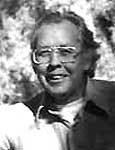 Guy
McCaskie (left, from an old photo) was the first to reach 600 species
in California, with a Baikal Teal at Lompoc, Santa Barbara Co., in Dec
2005. Guy remains 10–11 birds ahead of me on the State list. Guy
McCaskie (left, from an old photo) was the first to reach 600 species
in California, with a Baikal Teal at Lompoc, Santa Barbara Co., in Dec
2005. Guy remains 10–11 birds ahead of me on the State list.
Several other birders are now close to 600, including Bruce Barrett, Jon Dunn, and John Luther.
|
 I
missed the Baikal Teal as I was birding in the Philippines at the time.
[My wife Rita Carratello has that one on me!] I've been overseas when a
number of chaseable State birds were available, and I'm still looking
for Long-toed Stint, Ivory Gull, Black-tailed Gull, and Long-billed
Murrelet . . . . I
missed the Baikal Teal as I was birding in the Philippines at the time.
[My wife Rita Carratello has that one on me!] I've been overseas when a
number of chaseable State birds were available, and I'm still looking
for Long-toed Stint, Ivory Gull, Black-tailed Gull, and Long-billed
Murrelet . . . .
|
My run-up to #600 is shown in the panel below:
- #594 Bridled Tern Salton Sea 28 Jul 2008
- #595 Parakeet Auklet offshore SLO pelagic 24 Jan 2009
- #596 Taiga Bean-Goose Salton Sea 26 Nov 2010 [CBRC accepts as Taiga/Tundra Bean-Goose.]
- #597 split of Winter/Pacific Wren; eastern Winter Wren at Pt. Loma 26 Nov 2010
- #598 Common Ringed Plover Davis wetlands 21 Aug 2011
- #599 split of Xantus's Murrelet — I'd already seen both Scripps's & Guadalupe Murrelets
|
|
|
| So
this takes us to the Northern Gannet chase. It was first reported on SE
Farallon I. on 25 Apr 2012, was seen erratically thereafter, but became
more predictable late in summer 2012. The CBRC had actually accepted
the species — the first gannet to reach California — before I saw it. |
|
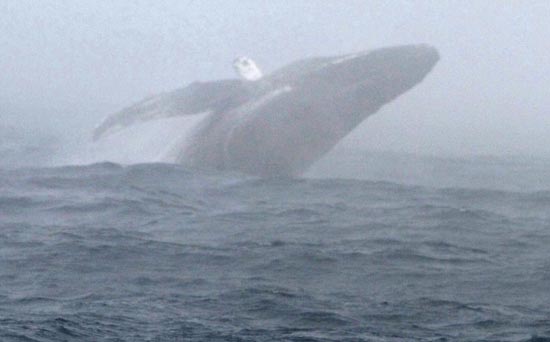 My
first two attempts to see the Northern Gannet were aboard
whale-watching boats from San Francisco. Each effort was hampered by
fog [above — fog at Farallones on 30 June 2012; right — Humpback
breeching in fog near Farallones on 18 August] and by the fact that our
visits were limited to about an hour at midday. As the summer wore on,
Farallon researchers learned that the Gannet typically appeared later
in the afternoon after foraging offshore all morning. Bruce Barrett and
others convinced Alvaro Jaramillo to charter a boat from Half Moon Bay
for a chase on 12 Sep. This was a dedicated 'gannet chase' trip, which
meant we would stay at the Farallones as late into the afternoon as we
could. We arrived about 11:30 a.m. but it took a long and stressful
four hours of circumnavigating and waiting until the Gannet appeared —
circling the lighthouse — at 3:31 p.m.! We had fine, albeit distant,
flight views until it landed at its presumed evening roost. Vignettes
of those views appear against the backdrop of our view of SE Farallon
I. (below). My
first two attempts to see the Northern Gannet were aboard
whale-watching boats from San Francisco. Each effort was hampered by
fog [above — fog at Farallones on 30 June 2012; right — Humpback
breeching in fog near Farallones on 18 August] and by the fact that our
visits were limited to about an hour at midday. As the summer wore on,
Farallon researchers learned that the Gannet typically appeared later
in the afternoon after foraging offshore all morning. Bruce Barrett and
others convinced Alvaro Jaramillo to charter a boat from Half Moon Bay
for a chase on 12 Sep. This was a dedicated 'gannet chase' trip, which
meant we would stay at the Farallones as late into the afternoon as we
could. We arrived about 11:30 a.m. but it took a long and stressful
four hours of circumnavigating and waiting until the Gannet appeared —
circling the lighthouse — at 3:31 p.m.! We had fine, albeit distant,
flight views until it landed at its presumed evening roost. Vignettes
of those views appear against the backdrop of our view of SE Farallon
I. (below). |
|
| Finally my goal of 600 birds in California has been achieved, just as I was fortunate to reach 5000 birds in the world
a decade ago. Yet there is still so much more to see! Indeed, on the
boat ride back to Half Moon Bay from the Farallones, we encountered a
wonderful Leatherback sea-turtle (below). That reminded me that I still
'need' two more sea-turtles in the world to complete "the sea-turtle
set" . . . . So much to do, so little time. |
|
|
|
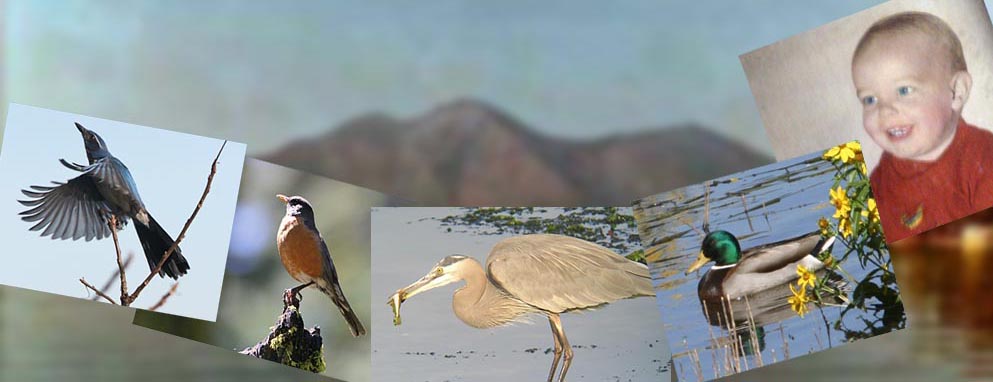

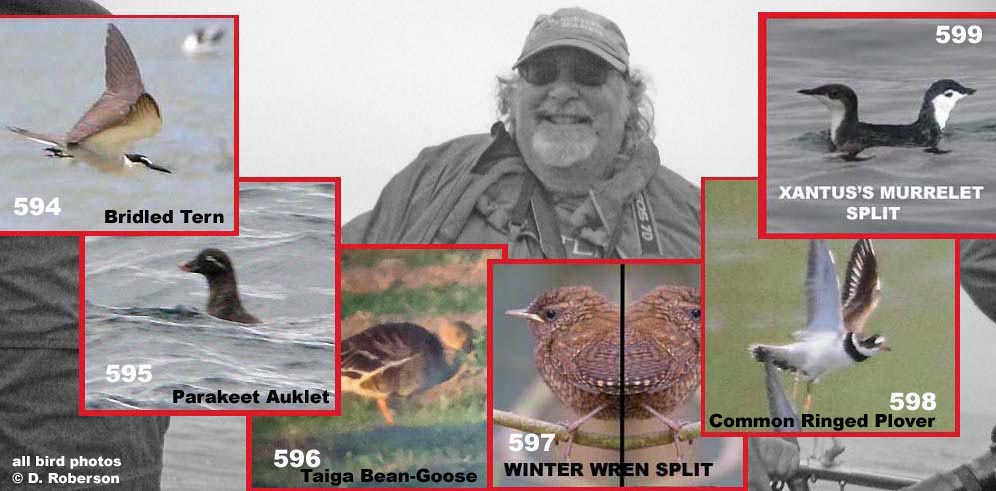

 My
first two attempts to see the Northern Gannet were aboard
whale-watching boats from San Francisco. Each effort was hampered by
fog [above — fog at Farallones on 30 June 2012; right — Humpback
breeching in fog near Farallones on 18 August] and by the fact that our
visits were limited to about an hour at midday. As the summer wore on,
Farallon researchers learned that the Gannet typically appeared later
in the afternoon after foraging offshore all morning. Bruce Barrett and
others convinced Alvaro Jaramillo to charter a boat from Half Moon Bay
for a chase on 12 Sep. This was a dedicated 'gannet chase' trip, which
meant we would stay at the Farallones as late into the afternoon as we
could. We arrived about 11:30 a.m. but it took a long and stressful
four hours of circumnavigating and waiting until the Gannet appeared —
circling the lighthouse — at 3:31 p.m.! We had fine, albeit distant,
flight views until it landed at its presumed evening roost. Vignettes
of those views appear against the backdrop of our view of SE Farallon
I. (below).
My
first two attempts to see the Northern Gannet were aboard
whale-watching boats from San Francisco. Each effort was hampered by
fog [above — fog at Farallones on 30 June 2012; right — Humpback
breeching in fog near Farallones on 18 August] and by the fact that our
visits were limited to about an hour at midday. As the summer wore on,
Farallon researchers learned that the Gannet typically appeared later
in the afternoon after foraging offshore all morning. Bruce Barrett and
others convinced Alvaro Jaramillo to charter a boat from Half Moon Bay
for a chase on 12 Sep. This was a dedicated 'gannet chase' trip, which
meant we would stay at the Farallones as late into the afternoon as we
could. We arrived about 11:30 a.m. but it took a long and stressful
four hours of circumnavigating and waiting until the Gannet appeared —
circling the lighthouse — at 3:31 p.m.! We had fine, albeit distant,
flight views until it landed at its presumed evening roost. Vignettes
of those views appear against the backdrop of our view of SE Farallon
I. (below). 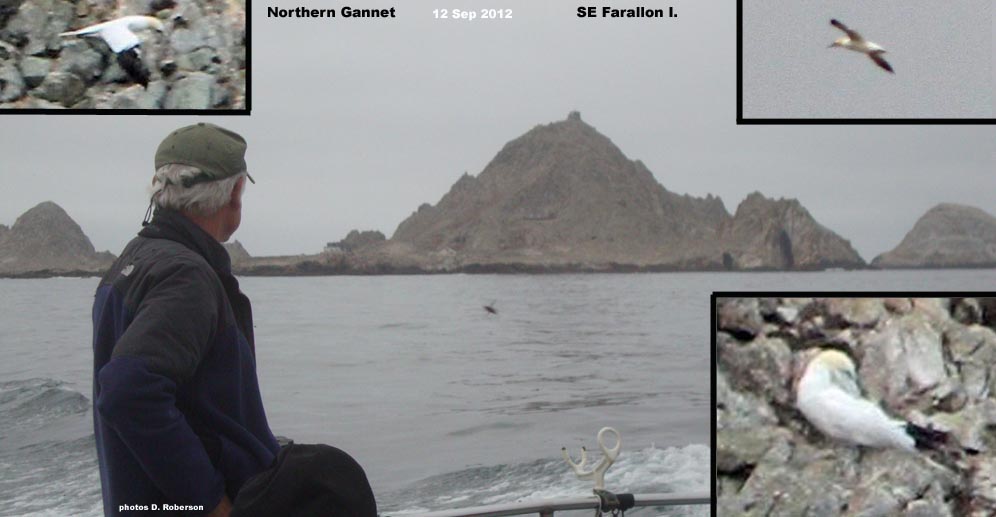
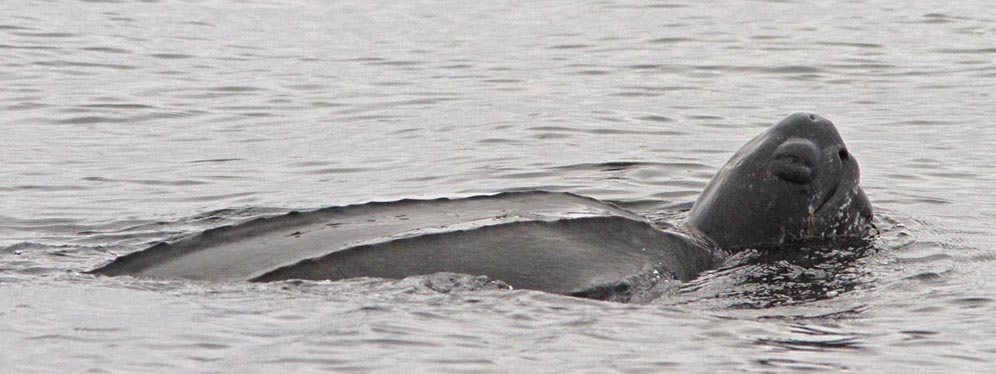
 Guy
McCaskie (left, from an old photo) was the first to reach 600 species
in California, with a Baikal Teal at Lompoc, Santa Barbara Co., in Dec
2005. Guy remains 10–11 birds ahead of me on the State list.
Guy
McCaskie (left, from an old photo) was the first to reach 600 species
in California, with a Baikal Teal at Lompoc, Santa Barbara Co., in Dec
2005. Guy remains 10–11 birds ahead of me on the State list.  I
missed the Baikal Teal as I was birding in the Philippines at the time.
[My wife Rita Carratello has that one on me!] I've been overseas when a
number of chaseable State birds were available, and I'm still looking
for Long-toed Stint, Ivory Gull, Black-tailed Gull, and Long-billed
Murrelet . . . .
I
missed the Baikal Teal as I was birding in the Philippines at the time.
[My wife Rita Carratello has that one on me!] I've been overseas when a
number of chaseable State birds were available, and I'm still looking
for Long-toed Stint, Ivory Gull, Black-tailed Gull, and Long-billed
Murrelet . . . .